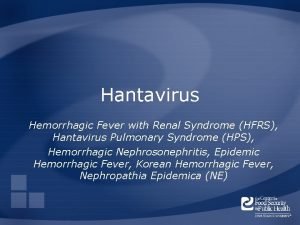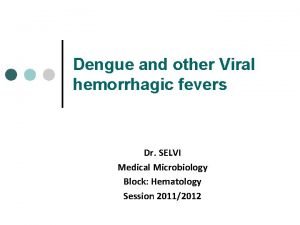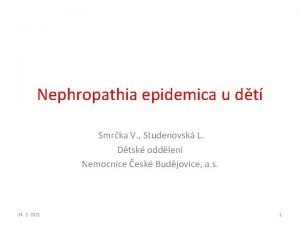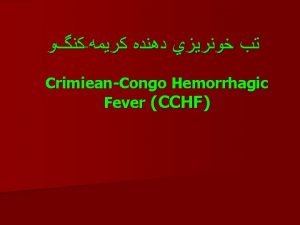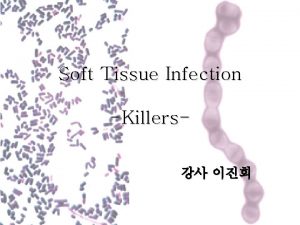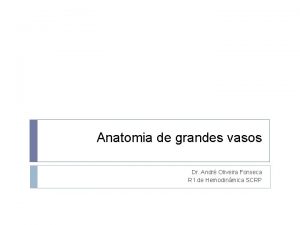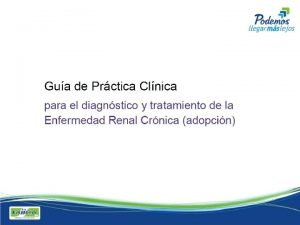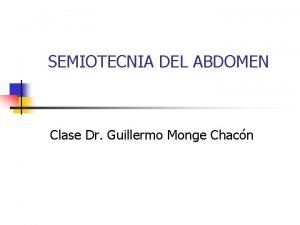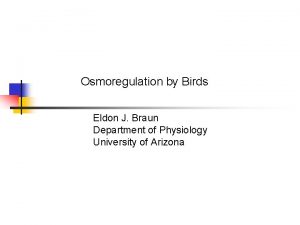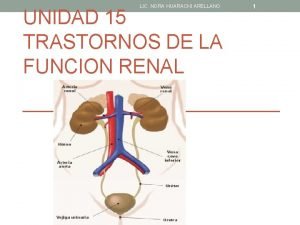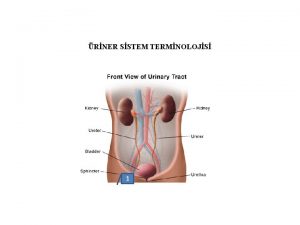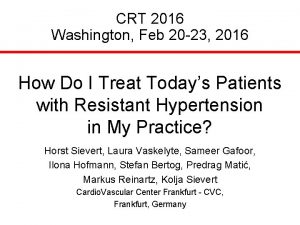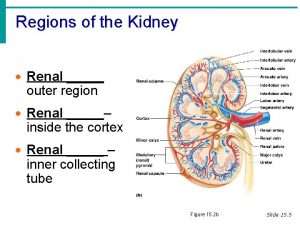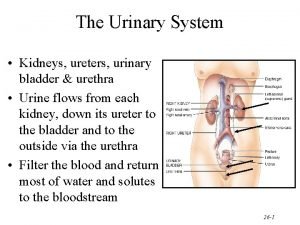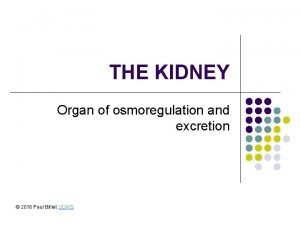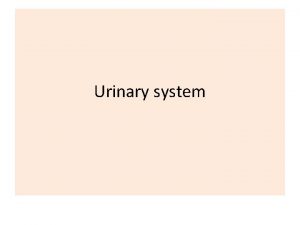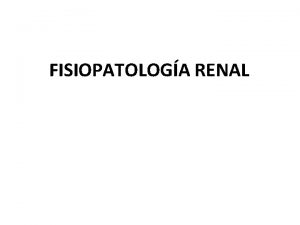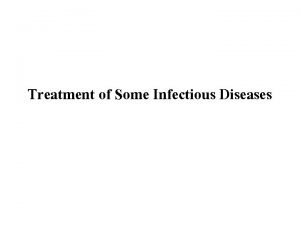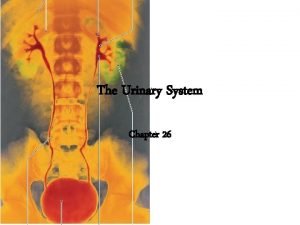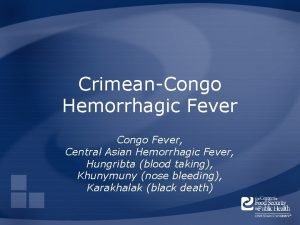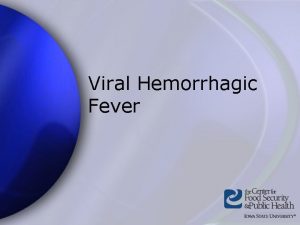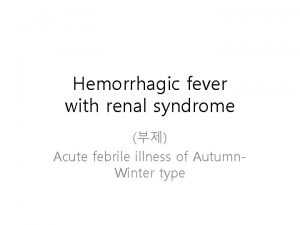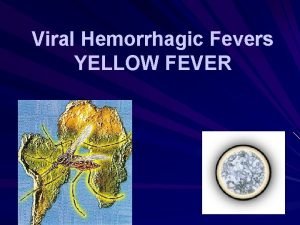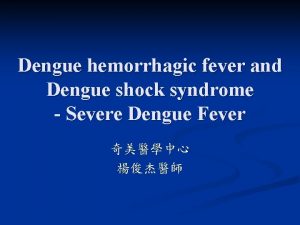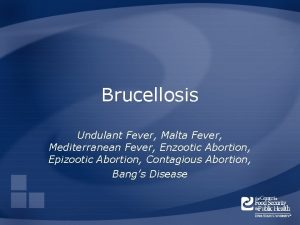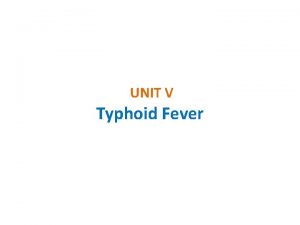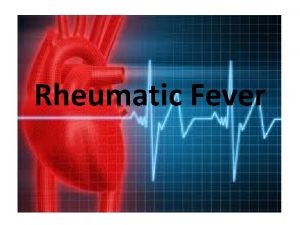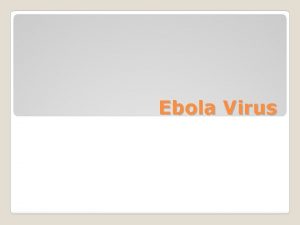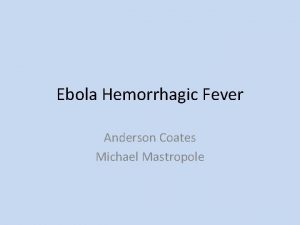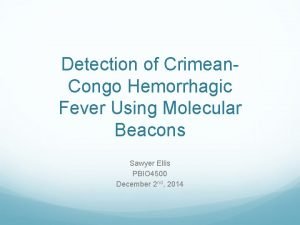Hantavirus Hemorrhagic Fever with Renal Syndrome HFRS Hantavirus






















































- Slides: 54

Hantavirus Hemorrhagic Fever with Renal Syndrome (HFRS), Hantavirus Pulmonary Syndrome (HPS), Hemorrhagic Nephrosonephritis, Epidemic Hemorrhagic Fever, Korean Hemorrhagic Fever, Nephropathia Epidemica (NE)

Overview • Organism • History • Epidemiology • Transmission • Disease in Humans • Disease in Animals • Prevention and Control Center for Food Security and Public Health, Iowa State University, 2013

THE ORGANISM

The Organism • Hantaviruses – Genus Hantavirus – Family Bunyaviridae • Group of antigenically distinct viruses carried in rodents and insectivores • More than 20 hantavirus species • Only genus not arthropod-borne Center for Food Security and Public Health, Iowa State University, 2013

The Organism • Different viruses cause different disease syndromes in humans – HFRS: Hemorrhagic fever with renal syndrome – HPS: Hantavirus pulmonary syndrome Center for Food Security and Public Health, Iowa State University, 2013

HFRS-Associated Viruses Serotype Host Location Hantaan Apodemus agrarius (Striped field mouse) Asia, Far East Russia Dobrava A. agrarius A. flavicollis (Yellow neck mouse) Europe Balkans Seoul Rattus norvegicus (Norway brown rat) R. rattus (Roof rat) Worldwide Puumala Clethrionomys glareolus (Red bank vole) Europe Center for Food Security and Public Health, Iowa State University, 2013

HPS-Associated Viruses Serotype Host Location Sin Nombre Peromyscus maniculatus (Deer mouse) Central and Western U. S Canada Monongahela P. maniculatus Eastern U. S. Canada New York P. leucopus (White-footed mouse) Eastern U. S. Canada Bayou Oryzomys palustris (Rice rat) Southeast U. S. Black Creek Canal Sigmodon hispidus (Cotton rat) Southeast U. S. Center for Food Security and Public Health, Iowa State University, 2013

HPS-Associated Viruses Serotype Host Location Andes Oligoryzomys longicaudatus (Long-tailed pygmy rice rat) Argentina Chile Oran (Andes variant) O. longicaudatus Northwest Argentina Lechiguanas (Andes variant) O. flavescens Central Argentina Hu 39694 (Andes variant) Unknown Central Argentina Juquitiba Unknown Brazil Center for Food Security and Public Health, Iowa State University, 2013

New World Hantaviruses New York Peromyscus leucopus Sin Nombre Peromyscus maniculatus Prospect Hill Microtus pennsylvanicus Muleshoe Sigmodon hispidus Bloodland Lake Microtus ochrogaster Isla Vista Bayou Microtus californicus Oryzomys palustris Black Creek Canal El Moro Canyon Sigmodon hispidus Reithrodontomys megalotis Rio Segundo Caño Delgadito Sigmodon alstoni Juquitiba Unknown Host Rio Mamore Oligoryzomys microtis Orán Oligoryzomys longicaudatus Bermejo Oligoryzomys chacoensis Andes Reithrodontomys mexicanus Laguna Negra Calomys laucha Maciel Necromys benefactus Hu 39694 Unknown Host Lechiguanas Oligoryzomys flavescens Pergamino Akodon azarae Oligoryzomys longicaudatus Center for Food Security and Public Health, Iowa State University, 2013

HISTORY Center for Food Security and Public Health, Iowa State University, 2013

History: Europe and Asia • American Civil War • World Wars I and II – 1913: – 1932: – 1934: Russia Manchuria Sweden • Nephropathia endemica Center for Food Security and Public Health, Iowa State University, 2013

History: Europe and Asia • 1951 -1954: Korea – 3, 200 U. N. troops affected – Hantaan River separated N. & S. Korea • 1977 – “Hantaan” virus isolated, characterized • 1979 – Similar virus found in laboratory workers in Japan and Europe – “Seoul” virus Center for Food Security and Public Health, Iowa State University, 2013

History: U. S. • 1993: Four Corners region – Sudden onset respiratory failure identified in healthy young people • 12 fatalities – Antibodies to hantavirus detected • Additional surveillance and testing – 1700 small mammals – 30% had antibodies to hantavirus • Sin Nombre virus identified Center for Food Security and Public Health, Iowa State University, 2013

The Four Corners Outbreak • May 1993 – First clinical case – Abrupt fever, myalgia, pulmonary edema • June 1993 – 12 fatalities – Unexplained Adult Respiratory Distress Syndrome (ARDS) – Sera cross-reacted with Hantaan, Seoul, Puumala virus – Rodents trapped - deer mouse main reservoir Center for Food Security and Public Health, Iowa State University, 2013

The Four Corners Outbreak • Winter and spring 1993 – Drought for several years followed by snow and rain – Vegetation blossomed and rodent population grew tenfold • Virus isolated and named – Sin Nombre Virus (SNV) • Newly emerging virus has been present since 1959 – 38 year old Utah man Center for Food Security and Public Health, Iowa State University, 2013

Four Corners Outbreak • Contributing factors – Drought followed by heavy snow and rain – Large increase in plant and animal numbers, especially deer mice – High infection rate Center for Food Security and Public Health, Iowa State University, 2013

Epidemic Curve of Four Corners Outbreak Center for Food Security and Public Health, Iowa State University, 2013

EPIDEMIOLOGY

Geographic Distribution • Found worldwide – Each virus range limited by host range • HPS-causing viruses – North, Central, and South America – U. S. : mostly Western states • HFRS-causing viruses – Europe and Asia Center for Food Security and Public Health, Iowa State University, 2013

Common Rodent Reservoirs • United States, except the Southeast – Deer mouse • Southeast U. S. – Cotton rat – Rice rat • Eastern – White-footed mouse • The house mouse is not a carrier! Center for Food Security and Public Health, Iowa State University, 2013

U. S. HPS Cases, By State of Exposure Center for Food Security and Public Health, Iowa State University, 2013

Risk Factors for Infection • Human exposure to rodents – Increased rodent populations – Environmental factors – Occupational exposures • Rodent control workers, field biologists, farmers, forestry workers, military – Recreational exposures • Camping, rodent-infested cabins • Cases peak in spring/early summer Center for Food Security and Public Health, Iowa State University, 2013

Morbidity and Mortality: Humans • Seroconversion – Europe: 1 to 8% • Varies by country and virus • Russia>Finland>Sweden>Others – U. S. : 0. 2 to 0. 5% – South America: 1 to 40% Center for Food Security and Public Health, Iowa State University, 2013

Morbidity and Mortality: Humans • Case fatality rate – Puumala virus: 0. 1 to 0. 4% – Seoul virus: 1 to 5% – Dobrava virus: 7 to 12% – Hantaan virus: 10 to 15% – Sin Nombre virus (HPS): 40 to 60% – Muleshoe, Black Creek Canal, Bayou viruses: >40% – Andes virus variants: 43 to 56% Center for Food Security and Public Health, Iowa State University, 2013

Annual Cases and Case. Fatality, U. S. , 1993 -2012 Center for Food Security and Public Health, Iowa State University, 2013

TRANSMISSION

Transmission • Animals – Virus spread by aerosols or bites – Virus shed in saliva, feces, urine – Viral shedding highest during early stages of infection • Humans – Incidental hosts – Infected by contact with infected or rodents or their droppings Center for Food Security and Public Health, Iowa State University, 2013

Transmission • Humans – Aerosolization of rodent urine, droppings, or nests in enclosed areas – Entry through broken skin, conjunctiva, other mucous membranes – Rodent bites – Ingestion – Vertical transmission (rare) Center for Food Security and Public Health, Iowa State University, 2013

Transmission Center for Food Security and Public Health, Iowa State University, 2013

Transmission • Other animals – Pigs • Shed virus and urine and feces • May also transmit virus vertically – Other species • Antibodies to hantaviruses reported • No virus shedding • Infected animals not linked to human cases Center for Food Security and Public Health, Iowa State University, 2013

Risk of Contracting HPS • Work, play, or live in closed spaces where rodents are actively living • Hikers and campers • Construction and utility workers – Enter crawl spaces under buildings – No serological evidence in 522 samples • Traveling to and within hantavirus areas is not a risk factor Center for Food Security and Public Health Iowa State University. 2013

DISEASE IN HUMANS

Incubation in Humans • HFRS – 1 to 6 weeks • HPS – 7 to 39 days (Andes virus) – 9 to 33 days (Sin Nombre virus) • Infections range from asymptomatic to severe Center for Food Security and Public Health, Iowa State University, 2013

Hemorrhagic Fever with Renal Syndrome • Severity varies with virus • Disease stages in severe cases – Febrile – Hypotensive/proteinuric – Oliguric – Diuretic – Convalescent Center for Food Security and Public Health, Iowa State University, 2013

Hemorrhagic Fever with Renal Syndrome • Abrupt onset fever, chills, aches • Onset of renal signs – Proteinuria oliguria polyuria – Hypotension – Nausea and vomiting – Kidney failure – Lung or neurological signs • Patients usually recover Center for Food Security and Public Health, Iowa State University, 2013

Hantavirus Pulmonary Syndrome • Initial phase – Fever, myalgia, headache • Cardiopulmonary phase – Abrupt respiratory distress – Cough – Tachypnea – Pulmonary edema – Cardiac abnormalities Center for Food Security and Public Health, Iowa State University, 2013

HPS: Clinical Presentation Most Frequent Other Fever Headache Shortness of breath Chills Nausea Dizziness Myalgias Vomiting Arthralgia Diarrhea Back pain Abdominal pain Chest pain Cough Sweats Center for Food Security and Public Health, Iowa State University, 2013

Hantavirus Pulmonary Syndrome • Disease progression – May be rapid after onset of cardiopulmonary phase – May require hospitalization and mechanical ventilation • Other symptoms – Mild kidney disease possible – Hemorrhagic disease rare Center for Food Security and Public Health, Iowa State University, 2013

Hantavirus: Other Infections • Some mild infections do not resemble HPS or HFRS • May cause of fever of unknown origin in Asia • Several atypical cases also diagnosed in Europe Center for Food Security and Public Health, Iowa State University, 2013

Diagnosis in Humans • Virus isolation – May be difficult – Some viruses have never been isolated • Serology – Immunofluorescent antibody test (IFA) – ELISA – Immunoblot – Virus neutralization Center for Food Security and Public Health, Iowa State University, 2013

Diagnosis in Humans • Immunohistochemistry – Tissues • RT-PCR – Blood or tissues – Can differentiate some viruses Center for Food Security and Public Health, Iowa State University, 2013

Treatment in Humans • Supportive care • Intensive care may be required • Ribavirin – HFRS only Center for Food Security and Public Health, Iowa State University, 2013

DISEASE IN ANIMALS

Species Affected • Hantaviruses found naturally in: – Rodents • Up to 50% seropositive • About 10% of deer mice seropositive for Sin Nombre virus – Insectivores (shrews and moles) • Most species carry only one virus Center for Food Security and Public Health, Iowa State University, 2013

Disease in Animals • Rodents – Can carry viruses but not usually do not become ill – Sporadic reports of clinical illness • Decreased survival • Decreased weight gain • Fatal pulmonary disease • Death (neonates) • Meningoencephalitis Center for Food Security and Public Health, Iowa State University, 2013

Disease in Animals • Other species – Can also be infected but little evidence of clinical illness – Antibodies found in: • Cats and dogs • Swine • Horses and cattle • Deer • Rabbits/hares and chipmunks • Moose Center for Food Security and Public Health, Iowa State University, 2013

PREVENTION AND CONTROL

Prevention and Control • Prevent exposure to rodents and their excretions – Occupational exposures – Exposures in the home – Agricultural exposures Center for Food Security and Public Health, Iowa State University, 2013

Prevention and Control • Rodent control in and around the home • CDC recommendations – Seal up – Trap up – Clean up Center for Food Security and Public Health, Iowa State University, 2013

Cleaning and Disinfection • Safe cleaning practices for rodentinfested areas and droppings – Wet area with disinfectant – Clean with paper towels, then mop or sponge – Avoid procedures that aerosolize virus (e. g. , sweeping) – Wear rubber gloves and mask – Contact health department for guidance Center for Food Security and Public Health, Iowa State University, 2013

Disinfection • 1% sodium hypochlorite – 10% sodium hypochlorite solution recommended for heavily soiled areas • 2% glutaraldehyde • 70% ethanol • Detergents • Acid (p. H 5) • Heat (60° C for at least 30 minutes) Center for Food Security and Public Health, Iowa State University, 2013

Prevention and Control • Occupational exposures – Wear recommended PPE • Detailed guidance available from CDC – Seek medical attention promptly if a febrile illness develops – Follow universal precautions in human healthcare settings – Quarantine and test laboratory rodents • No vaccine available Center for Food Security and Public Health, Iowa State University, 2013

Additional Resources • Center for Food Security and Public Health – www. cfsph. iastate. edu • CDC – www. cdc. gov/hantavirus/ • World Health Organization – www. who. int/ith/diseases/ Center for Food Security and Public Health, Iowa State University, 2013

Acknowledgments Development of this presentation was made possible through grants provided to the Center for Food Security and Public Health at Iowa State University, College of Veterinary Medicine from the Centers for Disease Control and Prevention, the U. S. Department of Agriculture, the Iowa Homeland Security and Emergency Management Division, and the Multi-State Partnership for Security in Agriculture. Authors: Kerry Leedom Larson, DVM, MPH, Ph. D, DACVPM; Anna Rovid Spickler, DVM, Ph. D; Radford Davis, DVM, MPH; Danelle Bickett-Weddle, DVM, MPH, Ph. D, DACVPM Reviewer: Glenda Dvorak, DVM, MPH, DACVPM Center for Food Security and Public Health, Iowa State University, 2013
 Hemorrhagic fever with renal syndrome
Hemorrhagic fever with renal syndrome Res extra commercium
Res extra commercium Diagnostico etiologico
Diagnostico etiologico Causes of viral hemorrhagic fever
Causes of viral hemorrhagic fever Nornik ceske budejovice 2021
Nornik ceske budejovice 2021 5 point hantavirus screen
5 point hantavirus screen Vasa recta vs peritubular capillaries
Vasa recta vs peritubular capillaries Syndrome hepato renal
Syndrome hepato renal Kinectio
Kinectio Types of haemorrhage
Types of haemorrhage Icp monitoring
Icp monitoring Stages of hemorrhagic shock
Stages of hemorrhagic shock Hemorrhagic vs ischemic stroke symptoms
Hemorrhagic vs ischemic stroke symptoms Hemorrhagic transformation mri
Hemorrhagic transformation mri Fever in toddlers when to worry
Fever in toddlers when to worry Cchf
Cchf Hemorrhagic diathesis
Hemorrhagic diathesis Facs
Facs Classes of hemorrhagic shock
Classes of hemorrhagic shock Necrotizing fasciitis hemorrhagic bullae
Necrotizing fasciitis hemorrhagic bullae Antihemorrhagic vitamin is also called
Antihemorrhagic vitamin is also called Pancreatitis pathophysiology
Pancreatitis pathophysiology Site:slidetodoc.com
Site:slidetodoc.com Veia renal
Veia renal Carcinoma renal de células claras fuhrman
Carcinoma renal de células claras fuhrman Sonido submate percusion
Sonido submate percusion Arteria renal
Arteria renal Infundibulo renal
Infundibulo renal Enfermedad renal cronica definicion
Enfermedad renal cronica definicion Maniobra de naegeli bazo
Maniobra de naegeli bazo Renal portal system
Renal portal system Lesion renal aguda
Lesion renal aguda Liver span
Liver span Difusi
Difusi Renal solea nedir
Renal solea nedir Renal denervation
Renal denervation Renal denervation
Renal denervation Renal tubule
Renal tubule Ureter diameter
Ureter diameter Puncte ureterale
Puncte ureterale Renal artery branches
Renal artery branches Ecuacion de henderson hasselbalch
Ecuacion de henderson hasselbalch Arterias miembro superior
Arterias miembro superior Urinary system also known as
Urinary system also known as Renal ven trombozu triad
Renal ven trombozu triad Usually
Usually Bowman's capsule
Bowman's capsule Insuficiencia renal
Insuficiencia renal Cvpath institute
Cvpath institute Functions of kidney
Functions of kidney Aeiou renal replacement therapy
Aeiou renal replacement therapy Ectopic kidney
Ectopic kidney Lamivudine renal dose
Lamivudine renal dose Renal function
Renal function Composition of normal urine
Composition of normal urine
